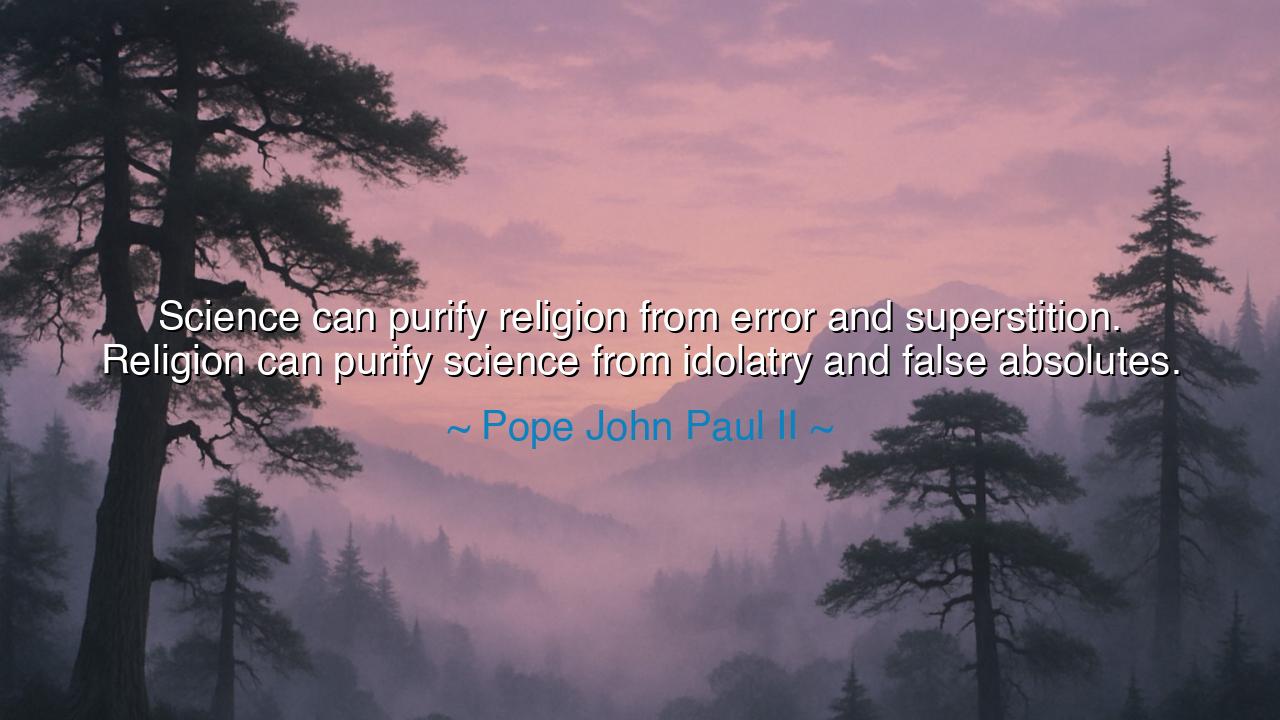
Science can purify religion from error and superstition. Religion
Science can purify religion from error and superstition. Religion can purify science from idolatry and false absolutes.






“Science can purify religion from error and superstition. Religion can purify science from idolatry and false absolutes.” — These words, spoken by Pope John Paul II, ring with the harmony of wisdom long sought by humankind. They bridge two mighty rivers — faith and reason, religion and science — that through the ages have too often flowed apart, sometimes even in opposition. Yet the Holy Father, in his clarity of vision, saw that the two are not enemies, but companions upon the same road, each capable of correcting and uplifting the other. In his insight, truth is not divided; it is a vast horizon approached from many paths.
The origin of this saying lies in John Paul II’s lifelong desire to heal the ancient wound between faith and knowledge. He lived in an age when scientific discovery was expanding faster than the moral imagination, and when religion, at times, clung too tightly to its traditions, fearing what new understanding might reveal. But the Pope, himself a philosopher and lover of truth, taught that science and religion are two wings on which the human spirit rises to contemplation of the divine. When one wing falters, the soul tilts toward error — for science without humility becomes pride, and faith without reason becomes superstition.
The first part of his saying speaks to the purifying power of science. Through observation, experiment, and logic, science reveals the hidden laws of creation. It dispels ignorance and reminds the faithful that true belief fears no knowledge. When religion forgets this — when it clings to myth over understanding, or confuses the mystery of God with the mistakes of men — science serves as the refining fire. It was through this lens that the Church, centuries after Galileo’s condemnation, recognized that faith must never fear discovery, for truth, in whatever form it takes, comes from God. Thus, science can free religion from the error and superstition that dim its light and make it the prisoner of human misunderstanding.
But John Paul II also saw the other danger — the arrogance of science without reverence, the idolatry of intellect that worships progress and calls it salvation. When man forgets the sacred and bows before the altar of technology or ideology, science itself becomes a false god. It builds weapons more swiftly than wisdom, and measures the world without weighing the soul. The Pope warned that religion must purify science, not by halting inquiry, but by recalling its purpose: that knowledge must serve life, not destroy it; that truth must be sought with humility; that the human being is not a machine, but a child of eternity. Religion, when pure, gives science its moral compass — guarding it from the false absolutes of pride, greed, and domination.
History has shown both sides of this balance. In the early twentieth century, men of science created the atomic bomb, believing they had touched omnipotence. Yet it was men of faith, such as Albert Schweitzer and Mahatma Gandhi, who reminded the world that progress without conscience is perilous. Conversely, when religion closed its eyes to reason — as during the trials of Galileo, or in the persecution of thinkers who dared to explore creation — it dimmed its own light. The greatest civilizations rose when these two forces walked together: the Greek philosophers seeking the divine order behind nature, the Islamic scholars preserving and expanding knowledge during Europe’s dark centuries, and the Christian thinkers of the Renaissance who saw God’s glory written in the laws of the cosmos.
The Pope’s words remind us that truth is a unity, and every fragment of it — whether born of prayer or of experiment — belongs to the same whole. Science reveals the “how” of the universe, while religion contemplates the “why.” One explains the mechanism; the other gives it meaning. One studies the visible, the other the invisible — yet both reach toward the same mystery. When joined, they form not conflict, but complement, each tempering the excess of the other and leading humanity closer to wisdom.
Therefore, beloved seeker of understanding, learn this lesson: never let your faith blind your reason, nor your reason numb your faith. Be humble before both creation and Creator. Let your search for knowledge be guided by love, and your devotion informed by truth. Study the stars — but also the heart that wonders at them. In the marriage of science and religion lies not contradiction, but completion: a harmony that exalts both the mind and the soul.
For this is the eternal rhythm of John Paul II’s teaching: that faith and reason are allies, not rivals, and that together they illuminate the full spectrum of truth. Science purifies belief from folly; religion purifies knowledge from arrogance. When both are held in balance, man no longer walks in halves, but in wholeness — a creature of body and spirit, reason and wonder, destined not merely to understand creation, but to revere it.






AAdministratorAdministrator
Welcome, honored guests. Please leave a comment, we will respond soon